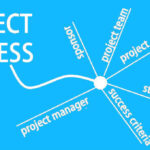How to Create a Workflow for Efficient Project Management.
Last Updated on October 15, 2021 by Owen McGab Enaohwo

Having a structured workflow is essential for any business. It is also one of the central things to achieving success in project management.
In reality, maintaining an efficient workflow is quite a challenge. If not done correctly, it will contribute not only to ineffective management but it will also affect productivity in a negative way and produce disengagement in the workplace.
To avoid these problems, the implementation of certain principles can help you achieve a stable project management workflow and improved business processes. Keep reading below to find out how this could be done.
Breaking Big Projects Down
First of all, breaking down tasks is a major contributor to creating a stable project management workflow. Nowadays, speed is one of the leading factors in business. With the intention to meet deadlines, often, project managers rush into setting up tasks for their teams, without preparing an actual structure to be followed. They rely on the Agile methodology of project management which yields better results than the classic waterfall approach, however, it still has its flaws.
One of them is the possible creation of a chaotic environment where different tasks are being scattered all over the place and big projects, get even bigger. As a result of this, work gets delayed and your clients remain unhappy with the final product or service.
A solution to this problem lies within breaking those projects down into smaller pieces. This can be done on all the hierarchical levels in the organization. For example, when there is a new strategic initiative, the CEO of the company can break it down into separate programs to be handled by specific managers. They can further break down the process into smaller projects to be handled by the dedicated project managers. This continues until the identification of individual tasks that enter the organization’s team level. Take for instance 56% of marketers use content marketing software to manage their workflow and distribution as part of their marketing strategy.
Talking about all of this is great until we reach the implementation phase. Unless visualizing the process, breaking down your work is almost impossible. However, there is a way to tackle this.
For example, at Kanbanize, we use the Portfolio Kanban management system. It allows us to create a stable workflow where the small, individual tasks are linked to the bigger initiatives. This way everybody stays up to date on what work is being processed which increases our productivity and efficiency.
Sorting Your Work Out
One of the main principles in management is to determine the short and long term goals of your company. Those are some of the decisions that separate good managers from the bad ones.
That’s why, to create an efficient project management workflow, you should be able to sort out the work that needs to be done. This means categorizing your work task manager.
In case you have already broken your project down in the previous step, you should have some individual tasks in mind. An idea to separate them by priority is to have three dedicated stages, where you distribute them accordingly. You can do that by using a Kanban board for example, which is a simple way to visualize your workflow and split it into different stages and classes of service.
There, you can visualize tasks that are planned for the distant future, while another portion of your work might be of higher importance in the near future. Finally, the work that your team is ready to start working on now, can reside in its respective stage.
By doing this, you will create a workflow that is predictable and stable. Your team members will know exactly what they should start working on next. This will not only boost their productivity but it will also increase their engagement in the workplace.
Pulling Individual Tasks
Creating an efficient project management workflow requires your team members to be involved in each stage of the process. Unfortunately, a lot of managers set some predefined responsibilities that the rest of their team should execute. This strategy is counterproductive to having a collaborative environment, which can mean disengagement in the workplace, damaged business processes, and unstable workflow.
To deal with this problem, a better approach would be to allow your team members to pull their own work and be responsible for it. After that, you need to control this system. A way to manage it is to set up Work In Progress Limits (WIP Limits) on the tasks that are being processed.
They are one of the core principles of the Kanban project management methodology which will allow you to make sure that your team members start new work item only when they have the capacity to do so. As a result of this, they will be less overloaded but more focused on their current tasks, which will increase their productivity and efficiency levels.
By integrating a pull approach, you will be able to create a smooth project management workflow. Your team will stay focused on executing the most important work just in time which will drive value and satisfaction to the end customer.
You can also use tools like FactoHr, which is an effective workflow-based solution that allows employees to mark their attendance or apply for leave from the portal or mobile device.
Monitoring and Optimization of Your Workflow
A rule of thumb to get results in the business world is to constantly monitor and optimize your processes. With that being said, creating a workflow that runs smoothly, requires continuous improvement.
Imagine that your organization generates too much waiting time when dealing with specific tasks. People are processing no work because they are expecting somebody else’s input. Delivery times are increasing and as a result of it, your customers are getting enraged. Sadly, this is the reality in many companies simply because they don’t integrate a culture that promotes continuous improvement.
Waiting time, for example, is categorized as one of the seven wastes of Lean. That’s why, to remove it, you need to visualize your entire workflow. This will allow you to see specifically which are the activities that generate value and which are those that produce waste. From then on, you can optimize accordingly and improve your business processes to transform your organization.
Bottom Line
Nowadays, businesses suffer from not being able to deliver their projects on time. To prevent this from happening with your projects, make sure that you create a workflow that is smooth and predictable. This way, you will be able to not just increase your team’s productivity but also the value delivery to your clients. After all, this is the most important business metric that is going to determine your rate of success.
About the author of this article:
Nikolay is a digital marketing professional and a Kanban expert at Kanbanize who delivers content on topics such as leadership, productivity and project management. Nick is passionate about entrepreneurship, consulting and growth hacking. Most of his time is spent either in the gym or playing football.
Get Your Free Systemization Checklist









Thankyou for such great and helpful information about digital marketing. It will definitely help me to increase my knowledge.
Glad you like the article